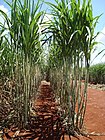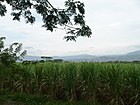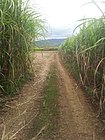Note: This is a project under development. The articles on this wiki are just being initiated and broadly incomplete. You can Help creating new pages.
Difference between revisions of "Saccharum Officinarum - Sugarcane"
(→References) |
|||
| (10 intermediate revisions by the same user not shown) | |||
| Line 1: | Line 1: | ||
| − | |||
[[File:Canass.JPG|thumb|right|''Saccharum Officinarum'']] | [[File:Canass.JPG|thumb|right|''Saccharum Officinarum'']] | ||
| − | '''Saccharum Officinarum''' is a large perennial grass. It produces thick culms that may grow up to 2 - 3 meters tall. A major crop in the tropics, where it is grown mainly for the sap in the stems which is used for making sugar, alcohol for fuel etc. | + | '''Saccharum Officinarum''' is a large perennial grass. It produces thick culms that may grow up to 2 - 3 meters tall. A major crop in the tropics, where it is grown mainly for the sap in the stems which is used for making sugar, alcohol for fuel etc.<ref name="Karnataka Medicinal Plants"/> |
==Uses== | ==Uses== | ||
| − | {{Uses|Piles}}, {{Uses|Headache}}, {{Uses|Indigestion}}, {{Kidney Stone}}, {{Diabetes}}, {{Jaundice}}, {{Headache}}, {{Indigestion}}<ref name="Karnataka Medicinal Plants"/>. | + | {{Uses|Piles}}, {{Uses|Headache}}, {{Uses|Indigestion}}, {{Uses|Kidney Stone}}, {{Uses|Diabetes}}, {{Uses|Jaundice}}, {{Uses|Headache}}, {{Uses|Indigestion}}<ref name="Karnataka Medicinal Plants"/>. |
==Parts Used== | ==Parts Used== | ||
| Line 9: | Line 8: | ||
==Chemical Composition== | ==Chemical Composition== | ||
| − | <ref name="chemical composition"/> | + | Sugarcane wax is used as a commercial source of long chain Fatty Alcohols, Acids, Esters, Aldehydes, and Ketones. Policosanols and D-003 along with some steroids and terpenoids have also been identified and isolated from sugarcane wax<ref name="chemical composition"/> |
==Common names== | ==Common names== | ||
| Line 46: | Line 45: | ||
==List of Ayurvedic medicine in which the herb is used== | ==List of Ayurvedic medicine in which the herb is used== | ||
| + | [[Amritapaasha Gritha]], [[Sitophalaadi Churna]], [[Sukumaara Gritha]], [[Sukumaara Rasayana]]<ref name="Karnataka Medicinal Plants"/> | ||
==Where to get the saplings== | ==Where to get the saplings== | ||
==Mode of Propagation== | ==Mode of Propagation== | ||
| − | {{Propagation|}} | + | {{Propagation|Seed}}, {{Propagation|Cuttings}} |
==How to plant/cultivate== | ==How to plant/cultivate== | ||
| Line 69: | Line 69: | ||
==References== | ==References== | ||
<references> | <references> | ||
| − | <ref name="chemical composition"> | + | <ref name="chemical composition">Journal paper from Nation Medicine Library - Phytochemical profile of sugarcane and its potential health aspects</ref> |
<ref name="Leaf">[Morphology]</ref> | <ref name="Leaf">[Morphology]</ref> | ||
| − | <ref name="How to plant/cultivate"> | + | <ref name="How to plant/cultivate">Useful Tropical plants - The Ferns Informtion</ref> |
<ref name="Karnataka Medicinal Plants">”Karnataka Medicinal Plants Volume-3” by Dr.M. R. Gurudeva, Page No.219 and 232, Published by Divyachandra Prakashana, #6/7, Kaalika Soudha, Balepete cross, Bengaluru</ref> | <ref name="Karnataka Medicinal Plants">”Karnataka Medicinal Plants Volume-3” by Dr.M. R. Gurudeva, Page No.219 and 232, Published by Divyachandra Prakashana, #6/7, Kaalika Soudha, Balepete cross, Bengaluru</ref> | ||
</references> | </references> | ||
==External Links== | ==External Links== | ||
| − | * [] | + | * [https://www.sciencedirect.com/topics/agricultural-and-biological-sciences/saccharum-officinarum#:~:text=1%20Sugarcane,the%20production%20of%20sugarcane%20spirits. Saccharum Officinarum on Sciencedirect - Agricultural and Biological sciences] |
| − | * [] | + | * [https://www.missouribotanicalgarden.org/PlantFinder/PlantFinderDetails.aspx?taxonid=285293 Saccharum Officinarum on Missouri Botanical Garden] |
| − | * [] | + | * [https://ntbg.org/database/plants/detail/saccharum-officinarum Saccharum Officinarum on Tropical plants database] |
[[Category:Ayurvedic Medicine]] | [[Category:Ayurvedic Medicine]] | ||
[[Category:Pages without herbs images]] | [[Category:Pages without herbs images]] | ||
Latest revision as of 07:12, 3 September 2023
Saccharum Officinarum is a large perennial grass. It produces thick culms that may grow up to 2 - 3 meters tall. A major crop in the tropics, where it is grown mainly for the sap in the stems which is used for making sugar, alcohol for fuel etc.[1]
Contents
- 1 Uses
- 2 Parts Used
- 3 Chemical Composition
- 4 Common names
- 5 Properties
- 6 Habit
- 7 Identification
- 8 List of Ayurvedic medicine in which the herb is used
- 9 Where to get the saplings
- 10 Mode of Propagation
- 11 How to plant/cultivate
- 12 Commonly seen growing in areas
- 13 Photo Gallery
- 14 References
- 15 External Links
Uses
Piles, Headache, Indigestion, Kidney Stone, Diabetes, Jaundice, Headache, Indigestion[1].
Parts Used
Chemical Composition
Sugarcane wax is used as a commercial source of long chain Fatty Alcohols, Acids, Esters, Aldehydes, and Ketones. Policosanols and D-003 along with some steroids and terpenoids have also been identified and isolated from sugarcane wax[2]
Common names
| Language | Common name |
|---|---|
| Kannada | Rasadaali Kabbu, Kempu kabbu |
| Hindi | Ganna |
| Malayalam | NA |
| Tamil | Ikku, Karambu |
| Telugu | Cheraku, Kantaramu |
| Marathi | NA |
| Gujarathi | |
| Punjabi | NA |
| Kashmiri | NA |
| Sanskrit | Rasaala, Gudadaaru |
| English | Shugercane |
Properties
Reference: Dravya - Substance, Rasa - Taste, Guna - Qualities, Veerya - Potency, Vipaka - Post-digesion effect, Karma - Pharmacological activity, Prabhava - Therepeutics.
Dravya
Rasa
Guna
Veerya
Vipaka
Karma
Prabhava
Habit
Identification
Leaf
| Kind | Shape | Feature |
|---|---|---|
Flower
| Type | Size | Color and composition | Stamen | More information |
|---|---|---|---|---|
| Flowering season is December to April |
Fruit
| Type | Size | Mass | Appearance | Seeds | More information |
|---|---|---|---|---|---|
| Fruiting season is December to April |
Other features
List of Ayurvedic medicine in which the herb is used
Amritapaasha Gritha, Sitophalaadi Churna, Sukumaara Gritha, Sukumaara Rasayana[1]
Where to get the saplings
Mode of Propagation
How to plant/cultivate
Grows best in a sunny position. A very greedy plant, soon exhausting the soil of nutrients. The plant is considered to be moderately tolerant to saline soil conditions and relatively tolerant of acid soils. Grows best in a position sheltered from strong winds. Prefers a pH in the range 5 - 8, but can tolerate 4.5 - 9. Well-grown plants can become invasive.[4]
Commonly seen growing in areas
[[:Category:Herbs that are commonly seen in the region of |]], [[:Category:Herbs that are commonly seen in the region of |]], [[:Category:Herbs that are commonly seen in the region of |]], [[:Category:Herbs that are commonly seen in the region of |]], [[:Category:Herbs that are commonly seen in the region of |]].
Photo Gallery
References
- ↑ 1.0 1.1 1.2 1.3 1.4 ”Karnataka Medicinal Plants Volume-3” by Dr.M. R. Gurudeva, Page No.219 and 232, Published by Divyachandra Prakashana, #6/7, Kaalika Soudha, Balepete cross, Bengaluru
- ↑ Journal paper from Nation Medicine Library - Phytochemical profile of sugarcane and its potential health aspects
- ↑ [Morphology]
- ↑ Useful Tropical plants - The Ferns Informtion
External Links
- Pages using duplicate arguments in template calls
- Ayurvedic Herbs known to be helpful to treat Piles
- Ayurvedic Herbs known to be helpful to treat Headache
- Ayurvedic Herbs known to be helpful to treat Indigestion
- Ayurvedic Herbs known to be helpful to treat Kidney Stone
- Ayurvedic Herbs known to be helpful to treat Diabetes
- Ayurvedic Herbs known to be helpful to treat Jaundice
- Herbs with Root used in medicine
- Herbs with Suger used in medicine
- Herbs with common name in Kannada
- Herbs with common name in Hindi
- Herbs with common name in Tamil
- Herbs with common name in Telugu
- Herbs with common name in Sanskrit
- Herbs with common name in English
- Habit - Perennial
- Index of Plants which can be propagated by Seed
- Index of Plants which can be propagated by Cuttings
- Herbs that are commonly seen in the region of
- Ayurvedic Medicine
- Pages without herbs images





